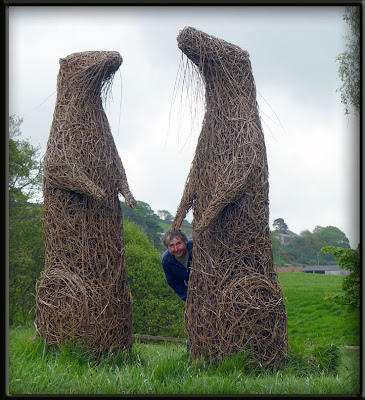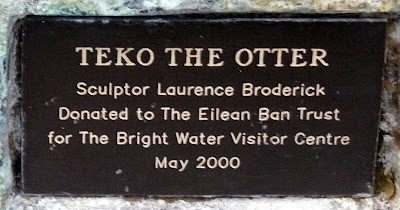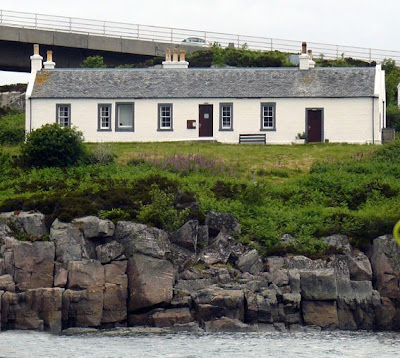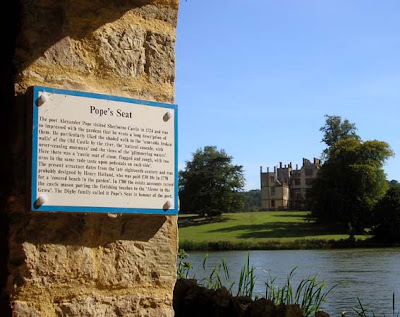

 Above: 'St Keverne' in bloom
Above: 'St Keverne' in bloomMiddle: Coverack, on the way to St Keverne
Below: Sign in the flower border: Middleton, Wales
The scene outside my window was a very wintry one yesterday morning, with white horses on the sea and grey clouds overhead. I went downstairs to make a cup of coffee. It was even darker in the dining room, that is until my eyes alighted on the startling Spring gold of the daffodils on the windowsill. It was a Proustian moment for me, as I remembered the madeleine.
Back in the late autumn we had been at Middleton, the National Botanic Garden of Wales, where we saw a green plant label in the earth saying 'St Keverne'. We looked forward to seeing these bulbs in flower, as St Keverne on the Lizard in Cornwall is a place that holds happy holiday memories for us. At that stage, the soil at Middleton was bare and there were no daffodil shoots in sight. Imagine my delight some weeks later, when we found 'St Keverne' bulbs for sale in a local garden centre, planted up in pots for Christmas.
We bought three pots, and kept one for ourselves. Hence the splash of gold on the windowsill. It transported me back to a happy day two summers ago when we were in St Keverne, a place I thought I knew well, with its fine church in the corner of the village square and its road to the treacherous rocks, aptly named The Manacles. On that particular day, we discovered something quite new to us in the vicinity of the village, and that was a small private museum of archaeological finds from the Lizard peninsula. The museum was at Poldowrian, on the site of a mesolithic-to-bronze-age settlement, and visiting hours were by appointment with the custodian. The site outside the museum building included a Bronze Age roundhouse. There was a lovely garden and an Iron Age cliff castle nearby. It was an idyllic afternoon.
It is strange how the human mind makes involuntary connections, and how a particular 'madeleine' - in this case a bright yellow one - can take us back unexpectedly to a past experience. As I look out over the estuary towards the Hartland light at the northern end of Cornwall, all I can see is a blanket of low cloud. I am grateful on a day like this for the splash of colour that transported me back to a carefree summer holiday in the Cornish sun. Proust can have his madeleine: I would prefer a saffron cake!
Back in the late autumn we had been at Middleton, the National Botanic Garden of Wales, where we saw a green plant label in the earth saying 'St Keverne'. We looked forward to seeing these bulbs in flower, as St Keverne on the Lizard in Cornwall is a place that holds happy holiday memories for us. At that stage, the soil at Middleton was bare and there were no daffodil shoots in sight. Imagine my delight some weeks later, when we found 'St Keverne' bulbs for sale in a local garden centre, planted up in pots for Christmas.
We bought three pots, and kept one for ourselves. Hence the splash of gold on the windowsill. It transported me back to a happy day two summers ago when we were in St Keverne, a place I thought I knew well, with its fine church in the corner of the village square and its road to the treacherous rocks, aptly named The Manacles. On that particular day, we discovered something quite new to us in the vicinity of the village, and that was a small private museum of archaeological finds from the Lizard peninsula. The museum was at Poldowrian, on the site of a mesolithic-to-bronze-age settlement, and visiting hours were by appointment with the custodian. The site outside the museum building included a Bronze Age roundhouse. There was a lovely garden and an Iron Age cliff castle nearby. It was an idyllic afternoon.
It is strange how the human mind makes involuntary connections, and how a particular 'madeleine' - in this case a bright yellow one - can take us back unexpectedly to a past experience. As I look out over the estuary towards the Hartland light at the northern end of Cornwall, all I can see is a blanket of low cloud. I am grateful on a day like this for the splash of colour that transported me back to a carefree summer holiday in the Cornish sun. Proust can have his madeleine: I would prefer a saffron cake!
- Stop Press and on a different note: Festival Fever and Carnival Mania! I am delighted to get a mention on the February Festival of the Trees. Thank you, Ashley. We are thrilled, too, that thanks to Chris, David's podcast features in Carnival of the Arid.



























